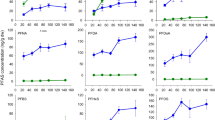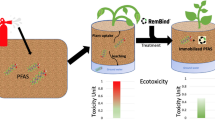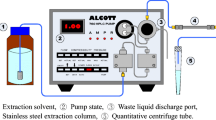Abstract
The presence of perfluorooctanoic acid (PFOA) and perfluorooctanesulphonic acid (PFOS) in crops is an important consideration for food safety. The soil organic matter (SOM) content may affect the adsorption potential of PFOA and PFOS in water and soil and their subsequent uptake in crops. To better understand these dynamics, the adsorption and uptake of PFOA and PFOS in lettuce were investigated using granular activated carbon (GAC)-treated soils with varying SOM content. The adsorption potential of GAC was investigated, with maximum adsorption capacities for PFOA and PFOS calculated to be 9.091 mg g−1 and 27.778 mg g−1, respectively. These values decreased to 5.208 mg g−1 and 17.241 mg g−1, respectively, after the addition of 0.04 wt% humic acid. The average plant uptake factor (PUF) in low and high perfluoroalkyl and polyfluoroalkyl acid (PFAA)-contaminated soils with 4.0 wt% SOM was restricted to 0.353 for PFOA and 0.108 for PFOS. The PUFs were approximately two times lower than those for soil with 2.6 wt% SOM. Addition of 1 wt% GAC to the soil successfully reduced the PUF by up to 99.4%, with values of 0.006 (PFOA) and 0.005 (PFOS) in 2.6 wt% SOM-treated soil and 0.079 (PFOA) and 0.023 (PFOS) in 4.0 wt% SOM-treated soil. Although the PUF in the GAC-treated soil was drastically decreased, the PUF of the soil with 4.0 wt% SOM was at least four times higher than that with 2.6 wt% SOM. Therefore, SOM content is an important consideration in the remediation of PFOA- and PFOS-contaminated farmland soil using carbonaceous adsorbent.


Similar content being viewed by others
References
Askeland, M., Clarke, B. O., Cheema, S. A., Mendez, A., Gasco, G., & Paz-Ferreiro, J. (2020). Biochar sorption of PFOS, PFOA, PFHxS and PFHxA in two soils with contrasting texture. Chemosphere, 249, 126072.
Bang, S.-Y., & Kim, J.-H. (2017). Isotherm, kinetic, and thermodynamic studies on the adsorption behavior of 10-deacetylpaclitaxel onto sylopute. Biotechnology and Bioprocess Engineering, 22(5), 620–630.
Bizkarguenaga, E., Zabaleta, I., Mijangos, L., Iparraguirre, A., Fernandez, L. A., Prieto, A., et al. (2016). Uptake of perfluorooctanoic acid, perfluorooctane sulfonate and perfluorooctane sulfonamide by carrot and lettuce from compost amended soil. Science of the Total Environment, 571, 444–451.
Blaine, A. C., Rich, C. D., Hundal, L. S., Lau, C., Mills, M. A., Harris, K. M., et al. (2013). Uptake of perfluoroalkyl acids into edible crops via land applied biosolids: Field and greenhouse studies. Environmental Science and Technology, 47(24), 14062–14069.
Blaine, A. C., Rich, C. D., Sedlacko, E. M., Hyland, K. C., Stushnoff, C., Dickenson, E. R., et al. (2014). Perfluoroalkyl acid uptake in lettuce (Lactuca sativa) and strawberry (Fragaria ananassa) irrigated with reclaimed water. Environmental Science and Technology, 48(24), 14361–14368.
Brambilla, G., D’Hollander, W., Oliaei, F., Stahl, T., & Weber, R. (2015). Pathways and factors for food safety and food security at PFOS contaminated sites within a problem based learning approach. Chemosphere, 129, 192–202.
Cho, H. J., Lee, Y. H., Choi, S. L., Seo, D. C., Min, S. R., & Heo, J. Y. (2019). Soil microbial communities of Japanese apricot (Prunus mume) orchard under organic and conventional management. Applied Biological Chemistry, 62, 71.
Choi, G. H., Lee, D. Y., Bae, J. Y., Rho, J. H., Moon, B. C., & Kim, J. H. (2018b). Bioconcentration factor of perfluorochemicals for each aerial part of rice. Journal of Applied Biological Chemistry, 61(2), 191–194.
Choi, G. H., Lee, D. Y., Bruce-Vanderpuije, P., Song, A. R., Lee, H. S., Park, S. W., et al. (2020). Environmental and dietary exposure of perfluorooctanoic acid and perfluorooctanesulfonic acid in the Nakdong-river, Korea. Environmental Geochemistry and Health. https://doi.org/10.1007/s10653-020-00721-0.
Choi, G.-H., Lee, D.-Y., Jeong, D.-K., Kuppusamy, S., Lee, Y. B., Park, B.-J., et al. (2017). Perfluorooctanoic acid (PFOA) and perfluorooctanesulfonic acid (PFOS) concentrations in the South Korean agricultural environment: A national survey. Journal of Integrative Agriculture, 16(8), 1841–1851.
Choi, G.-H., Lee, D.-Y., Seo, D.-C., Kim, L., Lim, S.-J., Ryu, S.-H., et al. (2018a). Endosulfan plant uptake suppression effect on char amendment in oriental radish. Water, Air, and Soil Pollution, 229(1), 24.
Eun, H., Yamazaki, E., Taniyasu, S., Miecznikowska, A., Falandysz, J., & Yamashita, N. (2020). Evaluation of perfluoroalkyl substances in field-cultivated vegetables. Chemosphere, 239, 124750.
Ghisi, R., Vamerali, T., & Manzetti, S. (2019). Accumulation of perfluorinated alkyl substances (PFAS) in agricultural plants: A review. Environmental Research, 169, 326–341.
Guo, R., Megson, D., Myers, A. L., Helm, P. A., Marvin, C., Crozier, P., et al. (2016). Application of a comprehensive extraction technique for the determination of poly- and perfluoroalkyl substances (PFASs) in Great Lakes Region sediments. Chemosphere, 164, 535–546.
Hale, S. E., Arp, H. P. H., Slinde, G. A., Wade, E. J., Bjorseth, K., Breedveld, G. D., et al. (2017). Sorbent amendment as a remediation strategy to reduce PFAS mobility and leaching in a contaminated sandy soil from a Norwegian firefighting training facility. Chemosphere, 171, 9–18.
Heo, J. J., Lee, J. W., Kim, S. K., & Oh, J. E. (2014). Foodstuff analyses show that seafood and water are major perfluoroalkyl acids (PFAAs) sources to humans in Korea. Journal of Hazardous Materials, 279, 402–409.
Jakob, L., Hartnik, T., Henriksen, T., Elmquist, M., Brandli, R. C., Hale, S. E., et al. (2012). PAH-sequestration capacity of granular and powder activated carbon amendments in soil, and their effects on earthworms and plants. Chemosphere, 88(6), 699–705.
Jian, J. M., Guo, Y., Zeng, L., Liang-Ying, L., Lu, X., Wang, F., et al. (2017). Global distribution of perfluorochemicals (PFCs) in potential human exposure source—A review. Environment International, 108, 51–62.
Kim, J. H., Ok, Y. S., Choi, G. H., & Park, B. J. (2015). Residual perfluorochemicals in the biochar from sewage sludge. Chemosphere, 134, 435–437.
Kupryianchyk, D., Hale, S. E., Breedveld, G. D., & Cornelissen, G. (2016). Treatment of sites contaminated with perfluorinated compounds using biochar amendment. Chemosphere, 142, 35–40.
Lee, D. Y., Choi, G. H., Rho, J. H., Lee, H. S., Park, S. W., Oh, K. Y., et al. (2020). Comparison of the plant uptake factor of perfluorooctanoic acid (PFOA) and perfluorooctane sulfonic acid (PFOS) from the three different concentrations of PFOA and PFOS in soil to spinach and Welsh onion. Journal of Applied Biological Chemistry, 63, 243–248.
Li, M., Sun, F., Shang, W., Zhang, X., Dong, W., Liu, T., et al. (2019). Theoretical studies of perfluorochemicals (PFCs) adsorption mechanism on the carbonaceous surface. Chemosphere, 235, 606–615.
Liu, Z., Lu, Y., Shi, Y., Wang, P., Jones, K., Sweetman, A. J., et al. (2017). Crop bioaccumulation and human exposure of perfluoroalkyl acids through multi-media transport from a mega fluorochemical industrial park, China. Environment International, 106, 37–47.
Liu, Z., Lu, Y., Song, X., Jones, K., Sweetman, A. J., Johnson, A. C., et al. (2019). Multiple crop bioaccumulation and human exposure of perfluoroalkyl substances around a mega fluorochemical industrial park, China: Implication for planting optimization and food safety. Environment International, 127, 671–684. https://doi.org/10.1016/j.envint.2019.04.008.
Luo, L., Kim, M. J., Park, J., Yang, H. D., Kho, Y., Chung, M. S., et al. (2019). Reduction of perfluorinated compound content in fish cake and swimming carb by different cooking methods. Applied Biological Chemistry, 62, 44.
Mahinroosta, R., & Senevirathna, L. (2020). A review of the emerging treatment technologies for PFAS contaminated soils. Journal of Environmental Management, 255, 109896.
Martz, M., Heil, J., Marschner, B., & Stumpe, B. (2019). Effects of soil organic carbon (SOC) content and accessibility in subsoils on the sorption processes of the model pollutants nonylphenol (4-n-NP) and perfluorooctanoic acid (PFOA). Science of the Total Environment, 672, 162–173.
McSachlan, M. S., Felizeter, S., Klein, M., Kotthoff, M., & De Voogt, P. (2019). Fate of a perfluoroalkyl acid mixture in an agricultural soil studied in lysimeters. Chemosphere, 223, 180–187.
Milinovic, J., Lacorte, S., Vidal, M., & Rigol, A. (2015). Sorption behavior of perfluoroalkyl substances in soil. Science of the Total Environment, 511, 63–71.
Navarro, I., de la Torre, A., Sanz, P., Porcel, M. A., Pro, J., Carbonell, G., et al. (2017). Uptake of perfluoroalkyl substances and halogenated flame retardants by crop plants grown in biosolids-amended soils. Environmental Research, 152, 199–206.
Perez, F., Llorca, M., Kock-Schulmeyer, M., Skrbic, B., Oliveira, L. S., da Boit Martinello, K., et al. (2014). Assessment of perfluoroalkyl substances in food items at global scale. Environmental Research, 135, 181–189.
Santos, A., Rodriguez, S., Pardo, F., & Romero, A. (2016). Use of Fenton reagent combined with humic acids for the removal of PFOA from contaminated water. Science of the Total Environment, 563–564, 657–663.
Seong, H. J., Kwon, S. W., Seo, D.-C., Kim, J.-H., & Jang, Y.-S. (2019). Enzymatic defluorination of fluorinated compounds. Applied Biological Chemistry, 62(1), 1–8.
Silvani, L., Cornelissen, G., Botnen Smebye, A., Zhang, Y., Okkenhaug, G., Zimmerman, A. R., et al. (2019). Can biochar and designer biochar be used to remediate per- and polyfluorinated alkyl substances (PFAS) and lead and antimony contaminated soils? Science of the Total Environment, 694, 133693.
Stockholm Convention. (2019). All POPs listed in the Stockholm Convention. Resource document. Retrieved 01 May 2020 from http://www.pops.int/TheConvention/ThePOPs/AllPOPs/tabid/2509/Default.aspx/.
Sungur, Ş. (2018). Dietary exposure to perfluorooctanoic acid (PFOA) and perfluorooctane sulfonic acid (PFOS): A review of recent literature. Toxin Reviews, 37(2), 106–116.
Wang, F., Shih, K., & Leckie, J. O. (2015). Effect of humic acid on the sorption of perfluorooctane sulfonate (PFOS) and perfluorobutane sulfonate (PFBS) on boehmite. Chemosphere, 118, 213–218.
Weber, R., Bell, L., Watson, A., Petrlik, J., Paun, M. C., & Vijgen, J. (2019). Assessment of pops contaminated sites and the need for stringent soil standards for food safety for the protection of human health. Environmental Pollution, 249, 703–715.
Wen, B., Pan, Y., Shi, X., Zhang, H., Hu, X., Huang, H., et al. (2018). Behavior of N-ethyl perfluorooctane sulfonamido acetic acid (N-EtFOSAA) in biosolids amended soil-plant microcosms of seven plant species: Accumulation and degradation. Science of the Total Environment, 642, 366–373.
Xia, Y., Zhang, M., Tsang, D. C. W., Geng, N., Lu, D., Zhu, L., et al. (2020). Recent advances in control technologies for non-point source pollution with nitrogen and phosphorous from agricultural runoff: Current practices and future prospects. Applied Biological Chemistry, 63, 8.
Xiang, L., Chen, L., Yu, L. Y., Yu, P. F., Zhao, H. M., Mo, C. H., et al. (2018). Genotypic variation and mechanism in uptake and translocation of perfluorooctanoic acid (PFOA) in lettuce (Lactuca sativa L.) cultivars grown in PFOA-polluted soils. Science of the Total Environment, 636, 999–1008.
Xiang, L., Li, Y. W., Yu, P. F., Feng, N. X., Zhao, H. M., Li, H., et al. (2020). Food safety concerns: Crop breeding as a potential strategy to address issues associated with the recently lowered reference doses for perfluorooctanoic acid and perfluorooctane sulfonate. Journal of Agricultural Food Chemistry, 68(1), 48–58.
Xiao, X., Ulrich, B. A., Chen, B., & Higgins, C. P. (2017). Sorption of poly- and perfluoroalkyl substances (PFASs) relevant to aqueous film-forming foam (AFFF)-impacted groundwater by biochars and activated carbon. Environmental Science and Technology, 51(11), 6342–6351.
Yu, J., Lv, L., Lan, P., Zhang, S., Pan, B., & Zhang, W. (2012). Effect of effluent organic matter on the adsorption of perfluorinated compounds onto activated carbon. Journal of Hazardous Materials, 225–226, 99–106.
Zareitalabad, P., Siemens, J., Hamer, M., & Amelung, W. (2013). Perfluorooctanoic acid (PFOA) and perfluorooctanesulfonic acid (PFOS) in surface waters, sediments, soils and wastewater—A review on concentrations and distribution coefficients. Chemosphere, 91, 725–732.
Zhang, D., He, Q., Wang, M., Zhang, W., & Liang, Y. (2019). Sorption of perfluoroalkylated substances (PFASs) onto granular activated carbon and biochar. Environmental Technology. https://doi.org/10.1080/09593330.2019.1680744.
Zhao, H., Guan, Y., Zhang, G., Zhang, Z., Tan, F., Quan, X., et al. (2013). Uptake of perfluorooctane sulfonate (PFOS) by wheat (Triticum aestivum L.) plant. Chemosphere, 91(2), 139–144.
Acknowledgements
This work was supported by a grant from "Research Program for Agricultural Science & Technology Development," National Academy of Agricultural Science, Rural Development Administration (PJ01332102), and from the Ministry of Science and ICT (MSIT) through the National Research Foundation (NRF) of Korea (NRF-2019R1A4A1029125), Republic of Korea.
Author information
Authors and Affiliations
Contributions
D-YL performed the experiments and data collection; G-HC analysed the PFAAs in crop; I-WC, K-YO, and D-CS analysed the data for the adsorbent; DM discussed the results; and J-HK wrote and revised the manuscript. All authors read and approved the final manuscript.
Corresponding author
Ethics declarations
Conflict of interest
The authors declare that they have no conflict of interest.
Additional information
Publisher's Note
Springer Nature remains neutral with regard to jurisdictional claims in published maps and institutional affiliations.
Supplementary Information
Below is the link to the electronic supplementary material.
Rights and permissions
About this article
Cite this article
Lee, DY., Choi, GH., Megson, D. et al. Effect of soil organic matter on the plant uptake of perfluorooctanoic acid (PFOA) and perfluorooctanesulphonic acid (PFOS) in lettuce on granular activated carbon-applied soil. Environ Geochem Health 43, 2193–2202 (2021). https://doi.org/10.1007/s10653-020-00793-y
Received:
Accepted:
Published:
Issue Date:
DOI: https://doi.org/10.1007/s10653-020-00793-y




